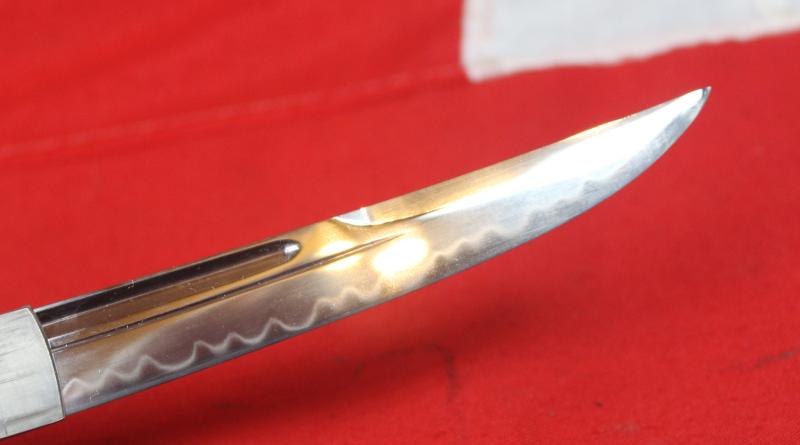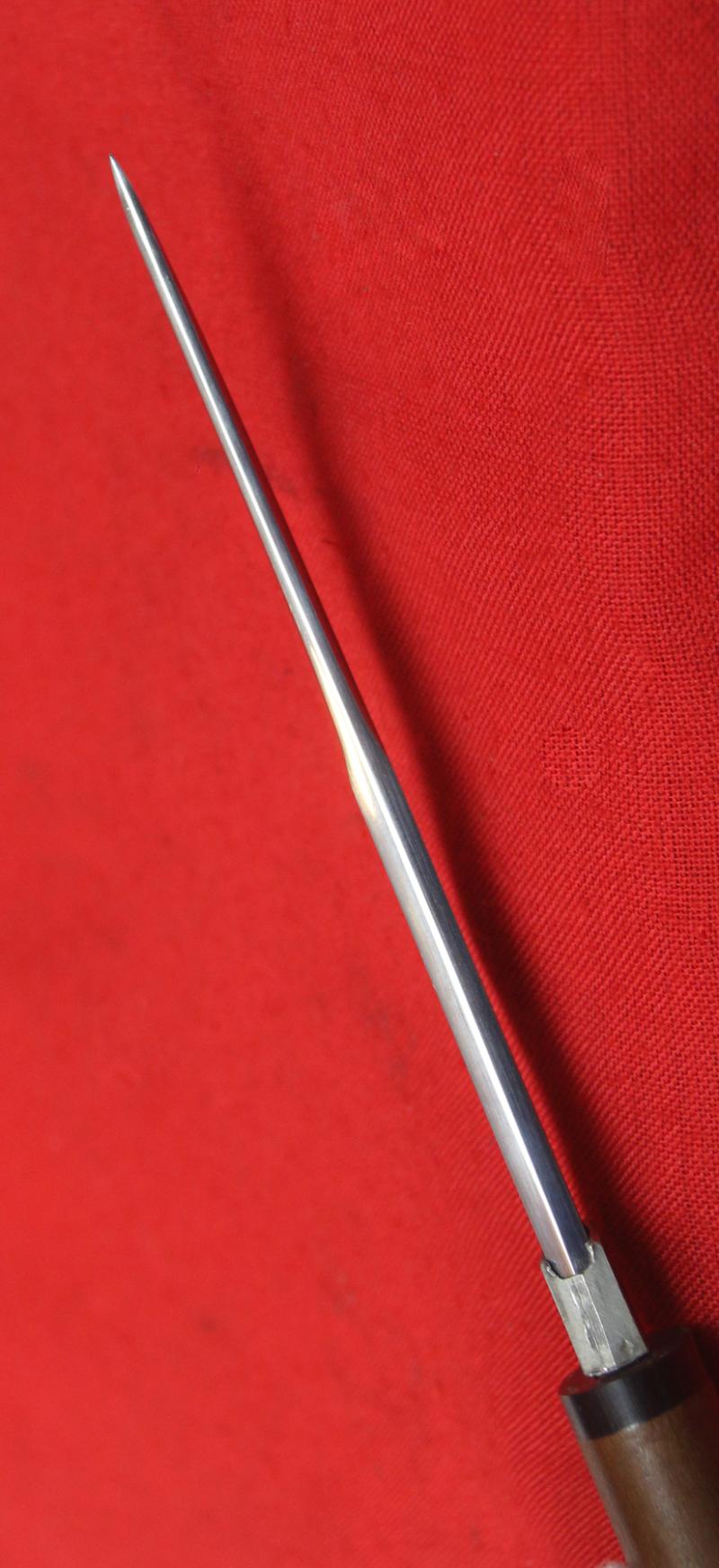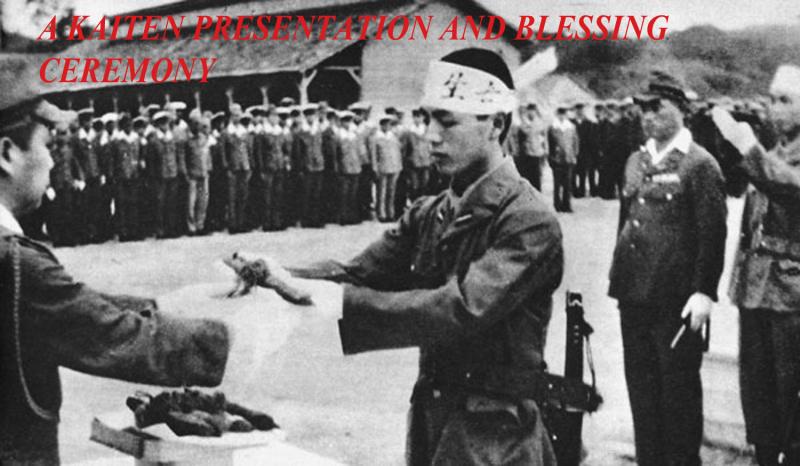A Very Good WW2 Japanese Kaiten or Zero Kamikaze Pilots 'Seppuku' {Hara-Kiri} Tanto Signed Seki {Mino} Junin Kanesada With Fine Hamon. This Is Certainly One Of, If Not The, Best Example We Have Seen in Decades
A traditional, signed, and most rare seppuku suicide dagger in shira saya standard wooden mounting. Issued in WW2
Unusually, signed on the blade face as a form of horimono. With a very good notare hamon and good kissaki turn back. Full hi to one side, and stunning gunome hamon. Nicely naturally aged short tang with early hand punched mekugi ana.
There is no set pattern that the knives conform to as they were not a standard issue they were privately purchased by the pilot himself or was given to him as a gift.
Every example is different, some have a blade inscription (hardly any), some had a leather scabbard cover like the swords have, and most do not have a signed Tang.
The very type as were presented to the WW2 Zero pilots before their Kamikaze suicide missions {see photo in the gallery} and also given to or purchased by Kaiten pilots, the Japanese navy's one man human suicide torpedoes. Blade wartime period, traditionally made. A must have piece, for collectors of fine Samurai edged weapons, who have yet to gain one of these most interesting daggers for their collection. Photo in the gallery shows a WW2 'Kamikaze' pilot being issued his suicide Seppuku tanto in the Kaiten ceremony. Originally they could have had an exterior brown leather cover and neck strap. The pilot had the choice whether to commit suicide, or not. It was not an order, nor directive and if the pilot missed the ship he had the option of killing himself to ask forgiveness of the honourable ancestors for his failure, as many of the planes had only enough fuel for a one way trip. Because the Zero pilot was belted into a very narrow seat and wearing many layers of his cold atmospheric pilot's flying suit with the addition of his life vest; it would be impossible for the aeronautical pilot to commit traditional ritual seppuku. It is said the procedure was to pull the knife out from it's neck sheath and thrust it straight into the throat much like the ladies form of seppuku. Fortunately and obviously this tanto’s original recipient likely failed in his task, and thus this fabulous and historical tanto survived the war intact.
This seppuku tanto survived the war simply because the pilot both aeronautical or maritime} failed in their mission, one way or another
In recognition of the unfavorable progress of the war, towards the end of 1943 the Japanese high command considered suggestions for various suicide craft. These suggestions were initially rejected, but later deemed necessary. Various suicide craft were developed in the Japanese Special Attack Units.
For the Navy, this meant Kamikaze planes, Ohka piloted bombs, Shinyo suicide boats, Kaiten submarines, and Fukuryu suicide divers or human mines. The Kamikazes were somewhat successful, and the second most successful were the Kaitens.
Research on the first Kaiten began in February 1944, followed on 25 July of the same year by the first prototype. By 1 August, an order for 100 units had been placed.
The island of Ōzushima, in the Inland Sea, was used as a training site. The island was equipped with cranes, torpedo testing pits, and launch ramps, and had a large shallow bay for test running and firing. The Kaiten Memorial Museum is now situated there.
Kaiten pilots were all men aged between 17 and 28. Initial training consisted of sailing fast surface boats by periscope and instrument readings alone. When a pilot had advanced past this basic training, he would begin training on Kaitens. Training craft were fitted with a dummy warhead that contained telemetry equipment and an emergency blowing tank that could return the craft to the surface should the trainee dive to a dangerous depth. Kaiten training started with basic circular runs to and from a fixed landmark at a reduced speed; the training advanced to faster and more hazardous runs around rocks and through channels in deeper waters. The more difficult runs required the pilot to surface and check the periscope repeatedly, and required conscientious adjusting of trim tank levels because of the reducing weight as oxygen was used up. When the instructors were confident about a pilot's abilities, they would advance the pilot to open water training against target ships. Training at this level was often done at full attack speed, and either at night or in twilight. The final phase of training would be a submarine launch and more open water attack runs on target ships.
Training was dangerous, and 15 men died in accidents, most commonly collisions with the target vessels. Although the warheads were only dummies, the impact at ramming speed was enough to both cripple the Kaiten and severely injure the pilot.
In action, the Kaiten was always operated by one man, but the larger training models (Types 2, 4, and 5) could carry two or even four.
Kaiten pilots who were leaving for their final missions would leave testaments and messages behind for their loved ones
Blade has a silver foiled pewter habaki and plain shira saya with black carved buffalo horn embellished trim.
Blade length from the base of habaki, 6.25 inches overall in saya 10.25 inches
As with all our items it comes complete with our certificate of authenticity
Code: 25551










